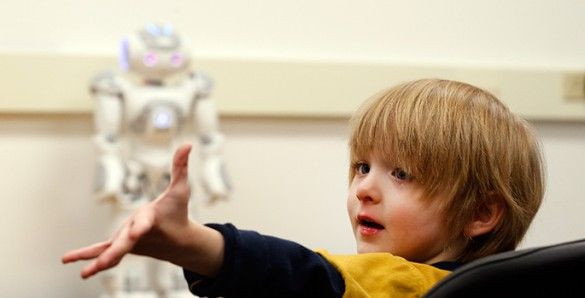Humanoid Robot Autism Treatment Teaches Children Social Skills [VIDEO]

Robot autism treatment is helping Aiden, a three-year-old boy with autism spectrum disorder (ASD), learn to socialize.
A team of autism treatment experts and mechanical engineers at Vanderbilt University modified a two-foot-tall humanoid robot called NAO (pronounced "now"), which they fitted with a sophisticated system of cameras, sensors, and computers designed to help children like Aiden interact with objects and people around them.
This skill, called joint attention, comes naturally to most "neurotypical" children, but autistic children's early deficits with it can build into greater learning difficulties as they grow older.
NAO exemplifies robot autism treatment's great potential to enhance the social learning ability of children with autism spectrum disorder.
One in 88 children today are being diagnosed with ASD, a 78 percent increase from four years ago, and the number is rapidly growing. Autism treatment is expensive- the lifetime healthcare costs for ASD patients are at least four times greater than for neurotypical patients- and trained therapists are in short supply for the rising demand.
The Vanderbilt researchers published a report in this month's issue of the IEEE Transactions on Neural Systems and Rehabilitation Engineering, which details how children with autism spectrum disorder paid attention to the humanoid robot in standard joint attention exercises almost as well as they did to a human therapist.
"This is the first real world test of whether intelligent adaptive systems can make an impact on ASD," said team member Zachary Warren, director of the Treatment and Research Institute for Autism Spectrum Disorders (TRIAD), to the Vanderbilt University newsletter.
The robot autism treatment was inspired by Nilanjan Sarkar, a Vanderbilt engineering professor who worked on psychological human-machine interfaces. Upon learning of his cousin's young son's autism spectrum disorder diagnosis while visiting India six years ago, Sarkar decided to apply his research towards developing a form of interactive robot autism therapy.
Research had established that young children with autism spectrum disorder, like most children, were entranced by humanoid robots.
"We knew that this gave us an advantage, but we had to figure out how to leverage it to improve the children's social skills," Sarkar said.
The research team he assembled developed a complex system that allowed the humanoid robot to adapt to feedback, which they called ARIA (Adaptive Robot-Mediated Intervention Architecture). ARIA has a "closed loop design," which means the robot modifies its actions according to an individual child's responses during treatment.
"There is a saying in the field, 'If you've seen one child with ASD, you've seen one child with ASD.' So one size does not fit all," said Warren. "To be useful, the system must be adaptive."
NAO, a commercial humanoid robot developed by a French company, was programmed with various verbal prompts like "look here!" and "let's do some more," accompanied by gestures like pointing and turning that are used in joint attention training.
The joint attention protocol starts with a verbal prompt to pay attention to an image or video, and if a child is unresponsive, the therapist gives stronger prompts, like pointing or turning her head. When the child responds, he gets positive feedback.
The Vanderbilt team tested the effectiveness of NAO's robot autism treatment in an "intelligent environment," which was fitted with wall flat panel screens and web cameras. Each autistic child who tested NAO sat in a chair facing the humanoid robot, which was stationed at the child's eye level at the front of the room. The cameras tracked each child's head movements so the computer could determine the direction of his or her gaze.
The robot autism treatment was tested on six two- to five-year-old children with autism spectrum disorder, and six neurotypicals children who served as controls. Each child went through alternating joint attention training sessions led by either a human therapist or the humanoid robot.
The results showed that children in both groups focused on the humanoid robot much more than they did on the human therapist. Neurotypical children watched the therapist more often than the autistic children did in human-led attention sessions, but children in both groups spent similar amounts of time watching NAO in the robot-led sessions.
"The children's engagement with the robot was excellent," said Julie Crittendon, professor of pediatrics at Vanderbilt, "and we saw improvements across the board in both groups."
The Vanderbilt team does not intend for humanoid robot autism treatment to fully replace human therapists, but to amplify their abilities.
"A therapist does many things that robots can't do," said Sarkar. "But a robot-centered system could provide much of the repeated practice that is essential to learning."
Sarkar hopes that robot autism treatment can help children learn necessary social skills more quickly at an early age, at a lower expense than constant feedback from therapists.
"The cost of robotic systems like this will continue to come down in the future so it should easily pay for itself by supplementing human intervention."
The Vanderbilt team is building on this study's success by developing more types of robot autism treatment, tailored to overcome other deficits in autism like role playing, sharing, and learning by imitation.



























